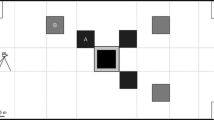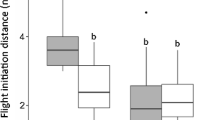Abstract
Dense vegetation cover undoubtedly offers certain advantages for small and slow-moving animals, but its disadvantages concerning some aspects of spatial ecology (e.g. movements) were neglected in previous studies. Tortoises could get stuck in vegetation by protuberant part of the shell and thus succumb to overheating, dehydration or predators. To examine how vegetation cover shapes behavioural responses of ‘trapped’ tortoises, we tested adults of six populations from habitats with contrasting vegetation cover. The tortoises were fitted with a non-stretchable rope, representing a piece of vegetation, stuck on the protruding front part of the plastron. Results suggested the existence of two distinct releasing techniques. First, and only successful in this study, is frequent changing of the movement direction, with a minimal pulling force, until the obstacle detached. The other involved the maximal pulling force aimed at ripping out the constraint. Tortoises from shrub habitats had more releasing success, used less pulling force and needed shorter time period to release, contrary to tortoises from herbaceous habitats. Although sexes showed similar releasing success, females obtained lower number of direction changes and higher yanking force compared to males, suggesting slightly different liberating strategies between the sexes. For immobilized tortoises without suitable shelter from overheating and dehydration, appropriate behavioural response could be vital, especially during drought years, due to increased physiological stresses. Variability of behavioural patterns among tortoise populations, described in this study, could have an adaptive significance.


Similar content being viewed by others
References
Bešić Lj (1978) Flora i Vegetacija Bjelopavlićke ravnice u Crnoj Gori. – Sveučilište u Zagrebu, Zagreb.
Bonnet X, Lagarde F, Henen BT, Corbini J, Nagy KA, Naulleau G, Balhoul K, Chastel O, Legrand A, Cambag R (2001) Sexual dimorphism in steppe tortoises (Testudo horsfieldii): influence of the environment and sexual selection on body shape and mobility. Biol J Linn Soc 72:357–372
Castro J, Zamora R, Hodar JA, Gomez JM, Gomez-Aparicio L (2004) Benefits of using shrubs as nurse plants for reforestation in Mediterranean mountains: a 4-year study. Restor Ecol 12:352–358
Cheylan M (1981) Biologie et ecologie de la tortue d’Hermann. Memoires Travailles EPHE 13:1–404
Corti C, Zuffi MAL (2003) Aspects of population ecology of Testudo hermanni hermanni from Asinara Island, NW Sardinia (Italy, western Mediterranean sea): preliminary data. Amphibia-Reptilia 24:441–447
Del Vecchio S, Burke RL, Rugiero L, Capula M, Luiselli L (2011) The turtle is in the details: microhabitat choice by Testudo hermanni is based on microscale plant distribution. Anim Biol 61:249–261
Dewitt TJ, Sih A, Wilson DS (1998) Costs and limits of phenotypic plasticity. Trends Ecol Evol 13:77–81
Djordjević S, Djurakić M, Golubović A, Ajtić R, Tomović L, Bonnet X (2011) Sexual body size and body shape dimorphism of Testudo hermanni in central and eastern Serbia. Amphibia-Reptilia 32:445–458
Em H (1965) Šumske zajednice četinara u NR Makedoniji. Biološki Glasnik Zagreb 15:1–38
Filippi E, Rugiero L, Capula M, Burke RL, Luiselli L (2010) Population and thermal ecology of Testudo hermanni hermanni in the Tolfa mountains of central Italy. Chelonian Conserv Bi 9:54–60
Fritz U, Auer M, Bertolero A, Cheylan M, Fattizzo T, Hundsdörfer AK, Sampayo MM, Pretus JL, Široký P, Wink M (2006) A rangewide phylogeography of Hermann’s tortoise, Testudo hermanni (Reptilia: Testudines: Testudinidae): implications for taxonomy. Zool Scr 35:531–543
Golubović A, Arsovski D, Ajtić R, Tomović L, Bonnet X (2013) Moving in the real world: tortoises take the plunge to cross steep steps. Biol J Linn Soc 108:719–726
Hailey A (2000) Assessing body mass condition in the tortoise Testudo hermanni. Herpetol J 10:57–61
Lagarde F, Louzizi T, Slimani T, El Mouden H, Ben Kaddour K, Moulherat S, Bonnet X (2012) Bushes protect tortoises from lethal overheating in arid areas of Morocco. Environ Conserv 39:172–182
Longepierre S, Hailey A, Grenot C (2001) Home range area in the tortoise Testudo hermanni in relation to habitat complexity: implications for conservation of biodiversity. Bodivers Conserv 10:1131–1140
Longshore KM, Jaeger JR, Sappington JM (2003) Desert tortoise (Gopherus agassizii) survival at two eastern Mojave Desert sites: death by short-term drought? J Herpetol 37:169–177
Loy A, Cianfrani C (2009) The ecology of Eurotestudo h. hermanni in a mesic area of southern Italy: first evidence of sperm storage. Ethol Ecol Evol 22:1–16
Luiselli L, Rugiero L (2006) Ecological modelling of habitat use and the annual activity patterns in an urban population of the tortoise, Testudo hermanni. Ital J Zool 73:219–225
Luiselli L, Rugiero L, Celletti S, Papi R, Gracceva G, Stacchiotti M, Mancini F, Berretta G, Berretta L, Bombara G, Fiaschetti R, Lucioli E, Trionfetti MG, Ungaro A (2009) Autumnal home range in radio-tracked tortoises (Testudo hermanni) from a semi-arid Mediterranean environment. Revue d’Ecologie (Terre et Vie) 64:73–78
Mazzotti S, Pisapia A, Fasola M (2002) Activity and home range of Testudo hermanni in northern Italy. Amphibia-Reptilia 23:305–312
Meek R (1984) Thermoregulatory behaviour in a population of Hermann’s tortoise (Testudo hermanni) in southern Yugoslavia. Brit J Herpetol 6:387–391
Niemela PT, Vainikka A, Forsman JT, Loukola OJ, Kortet R (2013) How does variation in the environment and individual cognition explain the existence of consistent behavioral differences? Ecology and Evolution 3:457–464
Pausas JG, Llovet J, Rodrigo A, Vallejo R (2008) Are wildfires a disaster in the Mediterranean basin?—a review. Int J Wildland Fire 17:713–723
Peterson CC (1994) Different rates and causes of high mortality in two populations of the threatened desert tortoise, Gopherus agassizii. Biol Conserv 70:101–108
Popgeorgiev G (2008) The effects of a large-scale fire on the demographic structure of a population of Hermann’s (Testudo hermanni boettgeri Mojsisovics, 1889) and Spur-thighed (Testudo graeca ibera Pallas, 1814) tortoises in Eastern Rhodopes Mountains, Bulgaria. Historia naturalis bulgarica 19:115–127
Rozylowicz L, Popescu DV (2012) Habitat selection and movement ecology of eastern Hermann’s tortoises in a rural Romanian landscape. Eur J Wildl Res 59:47–55
Sih A (1992) Forager uncertainty and the balancing of antipredator and feeding needs. Am Nat 139:1052–1069
Stubbs D (1981) Wildlife of the Alyki heaths, 1. Destruction by fire and plough. Animals 8:10–11
Swingland IR, Frazier JG (1979) The conflict between feeding and overheating in Aldabran giant tortoise. In: Amlaner CJ, MacDonald DW (eds) A handbook of Biotelemetry and Radio-tracking. Pergamon Press, Oxford & New York, pp 611–615
Türkozan O, Kiremit F, Taşkavak E, Olgun K (2005) Status, distribution, and population structure of land tortoises in Еuropean Тhrace and northwestern Аnatolia. Russ J Herp 12:187–194
Turner FB, Medica PA, Lyons CL (1984) Reproduction and survival of the desert tortoise (Scaptochelys agassizii) in Ivanpah Valley, California. Copeia 1984:811–820
Vetter H (2006) Hermann’s tortoise, Boettger’s and Dalmatian tortoises. – Chelonian Library, Edition Chimaira, Frankfurt am Main.
Willemsen RE, Hailey A (2003) Sexual dimorphism of body size and shell shape in European tortoises. J Zool 260:353–365
Acknowledgments
Many thanks to the members of the Serbian Herpetological Society ‘Milutin Radovanović’ and biology students from Serbia and Macedonia for their huge help in the field. Many thanks to Fifi and Xavier Bonnet for moral supports and provided equipment for the study. We are grateful to Gordan Kurbalija and his family for support. This study was supported by the Ministry of Education, Science and Technological Development of Republic of Serbia (grant no. 173043).
Author information
Authors and Affiliations
Corresponding author
Rights and permissions
About this article
Cite this article
Golubović, A., Andjelković, M., Arsovski, D. et al. Skills or strength—how tortoises cope with dense vegetation?. acta ethol 17, 141–147 (2014). https://doi.org/10.1007/s10211-013-0171-3
Received:
Revised:
Accepted:
Published:
Issue Date:
DOI: https://doi.org/10.1007/s10211-013-0171-3




